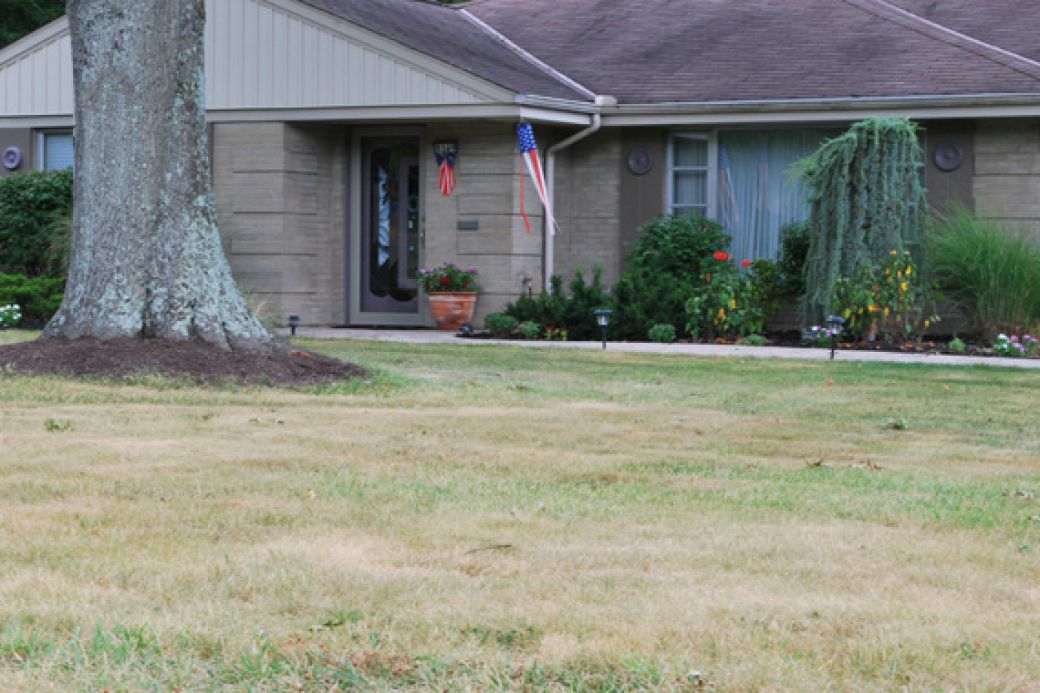Grass turns brown when roots can no longer grab nutrients or water from soil, or when soil doesn’t contain enough food or water.
Here are the typical culprits, and tips on how you can green up your grass again.
Drought/Heat
During periods of high heat and low water, many turf grasses go dormant. This is a normal condition; your grass will recover when the temperature drops and rain resumes.
To determine if drought is leading to brown grass, look for prematurely dropping tree leaves that are folded up like they’re praying for rain, says TV host Jason Cameron, a partner with TruGreen lawn care service.
To sustain a drought-dormant lawn, apply ½ inch of water every two or three weeks during the drought. To green it up again, apply 1 inch of water every 6 or 7 days — about 2 hours of sprinkler use. Or wait until temperatures drop and rain resumes, when it will turn green again on its own.
Sprinklers Misadjusted
If your lawn sports brown patches during heat waves, make sure your sprinklers are reaching all areas. Most sprinkler heads are easily adjusted with a small screwdriver. Low-to-the-ground pulsating (sometimes called impulse) sprinklers are easier to fine-tune than oscillating sprinklers.
Weeds
Common weeds can win the competition with your lawn for water and food. Controlling these weeds is tricky. Apply a pre-emergent herbicide in spring to prevent weed seeds from germinating. Or, hire a professional lawn care company that will customize an annual lawn maintenance and treatment plan.
Disease
Dozens of diseases and fungi can turn your lawn brown. If your grass is covered with white, black, or brown substances, then lawn disease is probably your problem and should be diagnosed and treated by a lawn specialist. Proper lawn care -- sufficient water in early morning, regular mowing, good lawn aeration, and thatch management -- will raise a healthy lawn more likely to resist lawn disease.
Cinch Bugs
These drought-loving bugs drain plant juices like tiny vampires. First your lawn will look wilted, then yellow, and eventually brown. Pull back a wilted patch and look for small red, orange, brown, or black bugs (1/32 to 1/5 inch depending on life stage) with white markings.
Thatch removal and consistent moisture are good preventative measures; insecticides are a last-ditch effort because many contain harsh chemicals that run off into the watershed and can harm beneficial insects.
Grubs
These beetle larvae feast on turf roots and mimic drought damage. Use a shovel to undercut a one-foot-by-one-foot square of turf, then peel back the patch and look for more than 10 grubs/square foot, which indicates a problem.
To control grubs, let your lawn dry out thoroughly before watering again. Or, plant low-maintenance turf grasses that are more grub-tolerant than Kentucky bluegrasses or perennial ryes. Also, you can try spreading milky spore powder, a natural organism that controls grubs.
Pet Waste
Round patches of dead grass indicate animals are peeing (urine contains acid) on your lawn. If you know a pet has a favorite spot, flush the area with water to dilute the acid.
Related: Landscaping Do's and Don'ts When You Have a Dog
If Necessary, Call in the Experts
Diagnosing the problem can be tricky, and your local extension agent or a lawn care company can help you determine exactly what ails your lawn.
Ounce of Prevention
Here are some prevention tips that will help your grass stay green, courtesy of Kevin Doerfler of Grass Seed USA.
- Aerate and inter-seed (add seed to existing grass) in fall when weather has cooled and rain is likely.
- Fertilize in spring and fall. Don’t fertilize when your grass already is stressed or during drought.
- Water in the early morning to combat fungal diseases. Water deeply to nourish roots.
- In summer, raise mowing height to 3 inches or above. The taller grass will shade roots and reduce water loss from evaporation.
- Perform a soil test to determine what amendments your lawn might need.
Related:
